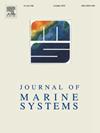河口生态系统对El Niño事件的响应——以长江口为例
IF 2.5
3区 地球科学
Q2 GEOSCIENCES, MULTIDISCIPLINARY
引用次数: 0
摘要
长江口(YRE)生态系统对El Niño事件的响应和适应认识有限,但不容忽视。基于2013年、2015年和2017年的YRE渔业调查数据,我们构建了代表El Niño事件之前、期间和之后三个不同时期的Ecopath模型并进行了比较。结果表明,El Niño发生后,YRE生态系统发生了显著变化。El Niño期间浮游植物和浮游动物生物量显著增加,而大部分鱼类和虾类生物量减少。El Niño期YRE生态系统平均营养水平低,能量转移效率低;一些生态网络测量(TPP/TR、TPP/TB、FCI)显示生态系统更加脆弱和受到高度干扰。在EI Niño事件后,这些变化大部分都有不同程度的恢复,放牧食物链中的物种比碎屑食物链中的物种恢复得更快。2013 - 2017年的变化反映了EI Niño对生态系统的复杂影响机制及其在气候扰动后的恢复力。本研究增强了我们对河口生态系统如何响应气候事件的认识,并可为气候变化下河口生态系统适应性管理策略的制定提供参考。本文章由计算机程序翻译,如有差异,请以英文原文为准。

Response of estuary ecosystem to El Niño event: A case study in the Yangtze River Estuary
The knowledge of how the Yangtze River Estuary (YRE) ecosystem responds to and adapts to the El Niño events is limited but cannot be ignored. Based on the fishery survey data in the YRE in 2013, 2015, and 2017, we constructed and compared three Ecopath models representing three different periods: before, during, and after El Niño event. Results showed that the YRE ecosystem underwent significant change after the occurrence of El Niño. Biomass of phytoplankton and zooplankton increased substantially during the El Niño period, while the biomass of most fish groups and shrimp decreased. During the El Niño period, the YRE ecosystem exhibited low mean trophic levels and low energy transfer efficiency; some ecological network measurements (TPP/TR, TPP/TB, FCI) indicated a more fragile and highly disturbed ecosystem. After the EI Niño event, most of these changes recovered to varying degrees, with species in grazing food chain recovering faster than in detrital based food chain. The variations from 2013 to 2017 reflected the complex impact mechanism of EI Niño on the ecosystem, as well as its resilience after climate disturbance. This study enhances our understanding of how estuarine ecosystems respond to climate events, and may serve as a reference for the development of adaptive management strategies under climate change.
求助全文
通过发布文献求助,成功后即可免费获取论文全文。
去求助
来源期刊

Journal of Marine Systems
地学-地球科学综合
CiteScore
6.20
自引率
3.60%
发文量
81
审稿时长
6 months
期刊介绍:
The Journal of Marine Systems provides a medium for interdisciplinary exchange between physical, chemical and biological oceanographers and marine geologists. The journal welcomes original research papers and review articles. Preference will be given to interdisciplinary approaches to marine systems.
 求助内容:
求助内容: 应助结果提醒方式:
应助结果提醒方式:


